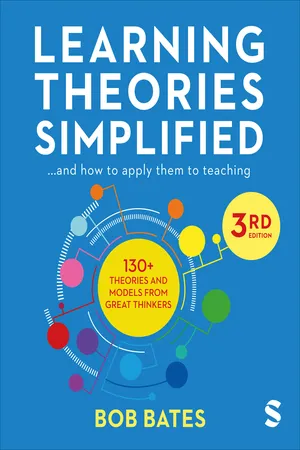
- 384 pages
- English
- ePUB (mobile friendly)
- Available on iOS & Android
About this book
Are you struggling to get your head around John Dewey's educational pragmatism? What exactly is Jean Piaget saying about cognitive development? Maybe you're running out of time and patience making sense of Rosenshine?s Principles of Instruction? Have you reached breaking point reading Daniel T. Willingham on educational neuroscience?
Written for busy teachers, students, trainers, managers and , this ?dip-in, dip-out? guide makes theories of learning accessible and practical. It explores 134 classic and contemporary learning theorists in an easy-to-use, bite-sized format with clear relevant illustrations on how each theory will benefit teaching and learning.
Each model or theory is explained in less than 350 words, followed by a ?how to use it? section.
New to this third edition:
Frequently asked questions
- Essential is ideal for learners and professionals who enjoy exploring a wide range of subjects. Access the Essential Library with 800,000+ trusted titles and best-sellers across business, personal growth, and the humanities. Includes unlimited reading time and Standard Read Aloud voice.
- Complete: Perfect for advanced learners and researchers needing full, unrestricted access. Unlock 1.4M+ books across hundreds of subjects, including academic and specialized titles. The Complete Plan also includes advanced features like Premium Read Aloud and Research Assistant.
Please note we cannot support devices running on iOS 13 and Android 7 or earlier. Learn more about using the app.
Information
Table of contents
- Cover
- Half Title
- Title Page
- Copyright Page
- Acknowledgements
- Praise for Bob’s work
- Contents
- About the author
- Acknowledgements
- New to this edition
- How to use this book
- Introduction
- Part 1 Classical Learning Theories
- Introduction to Part 1
- Section 1.1: Educational Philosophy
- Section 1.2: Behaviourism
- Section 1.3: Cognitivism
- Section 1.4: Humanism
- Section 1.5: Educational Neuroscience
- Summary of Part 1
- Part 2 Contemporary Thinking On Teaching And Learning
- Introduction to Part 2
- Section 2.1: Professionalism
- Section 2.2: Cognitive Learning Theory
- Section 2.3: Motivation
- Section 2.4: Behaviour Management
- Section 2.5: Coaching and Mentoring
- Section 2.6: Teamworking
- Summary of Part 2
- Part 3 An Introduction to Early Childhood and Developmental Strategies
- Introduction to Part 3
- Section 3.1: Children and Society
- Section 3.2: Emotional Growth
- Section 3.3: Classroom Strategies
- Section 3.4: Working with Children with Additional Needs
- Section 3.5: Different School Approaches
- Summary of Part 3
- Part 4 Planning, Delivering and Assessing Learning
- Introduction to Part 4
- Section 4.1: Curriculum Planning
- Section 4.2: Lesson Planning
- Section 4.3: Delivering Learning
- Section 4.4: Assessment and Feedback
- Section 4.5: Evaluating Teaching and Learning
- Summary of Part 4
- A Final Word on Teaching
- Index